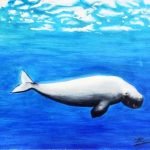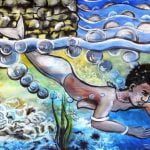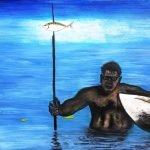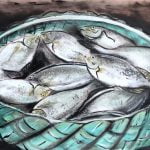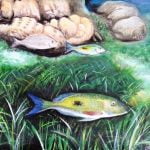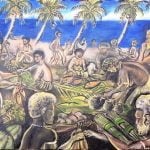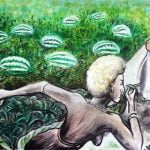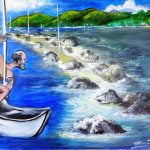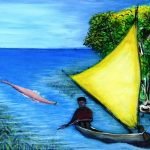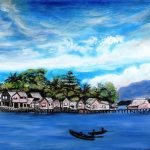The Art of Conservation: A conversation with Johan van der Ploeg
June 05, 2017
A few weeks ago Johan Van Der Ploeg from Worldfish in the Solomon Islands shared artwork with us by a Solomon Island artist named John Limaito’o:
It struck a cord. These were beautiful — an indigenous and culturally rich approach to conservation outreach. We had not seen this before.
Outreach is typically planned from offices, with computers and in consultation with ‘experts’ Connecting outreach with local art and emotion is not part of the calculation.
Yet, the art created by John Limaito’o turned our understanding upside down. This was art communicating conservation and the art was communicating local culture. We were, well, impressed.
So, we contacted Johan and asked him difficult and sometimes naive questions. He responded with care and a generosity of thought. Here is the interview. We learned a lot:
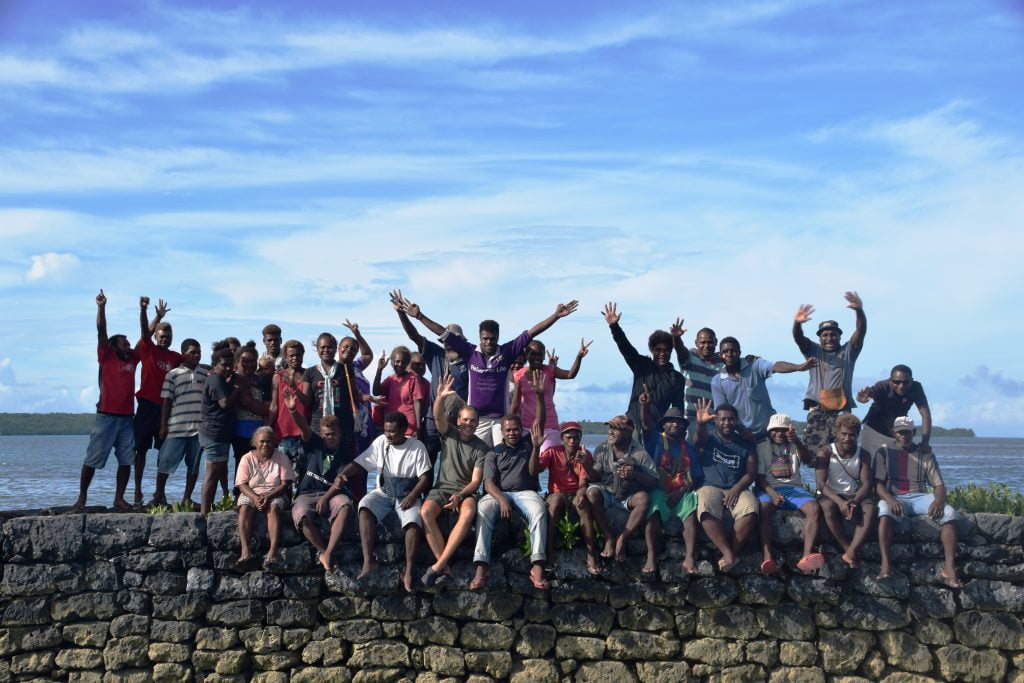
Johan, can you tell us about yourself and why you are in the Solomon Islands?
I am an environmental anthropologist, with an interest in community based conservation. I have been working for WorldFish in Solomon Islands since 2015.
Is there a strong link between nature and the people who live in the Solomon Islands?
Most people in Solomon Islands depend directly on the sea, soil and the sky for their subsistence. It is estimated that 85% of the population relies on farming and fishing as their main source of livelihood. People have strong cultural links to their land and nature, and take pride in their culture and their traditions. People respect ancestor crocodiles, tell stories about shark worshipping, and guard sacred sites.
What about the links between Solomon communities and dugongs and seagrass? Have people heard of them? Is the attitude to dugongs and seagrass different from community to community?
In the Lau Lagoon in North Malaita, which contains the largest seagrass areas in the Solomon Islands, some tribes consider dugongs as a ‘taboo’ animal: they cannot kill or eat it. People tell the myth of a women, Faifu, who was badly treated by her mother-in-law and changed into a dugong.
What is the connection between art, culture and conservation? People have an emotional connection to art. It can make us laugh, cry, and even understand something from a different perspective. Can art change our understanding of conservation?
Conservation is about people and about changing the behavior of people. Cultural values and emotions play an important role in that process. But most of the time conservationists often focus on rational things: they talk about the law and about economic values of species and habitats, and ignore the cultural dimension. But ultimately people are motivated to protect species such as dugongs, because of traditions, emotions and moral values. Love, respect, beliefs, beauty and fun are much stronger incentives to protect species than cash, also in poor areas in the development world.
The artists name is John Limaito’o. Who is this man? Where is he from? What sort of art does he make? Is he well-known?
John Limaito’o is a talented, young artist from Central Kwara’ae on Malaita. In 2006 he got a scholarship to study arts in Bandung, Indonesia. But he had to stop his studies and return home when his father died. Painting remained his passion, but on Malaita you can’t make a living with art. John and his brother operate a cocoa dryer to earn some cash. John became a father in February 2017. He had never visited Lau Lagoon and had never seen a dugong.
How did you work with the artist to make sure his art reflected the conservation message you wanted to explore?
We are working on an informative poster on dugong and seagrass conservation in Lau Lagoon. We needed paintings that tell a specific story. That requires a lot of dialogue. John made 5 (!) different versions of the painting on the dugong channel. I gave John several photographs as examples, but copying these images didn’t work out. In the end, the best approach was to give John a free hand and relied entirely on his imagination and creativity.
Have you had experiences with using art for conservation issues? Can you tell us more about that experience? Have you worked before to connect culture, art and conservation?
I worked ten years in the Philippines on a project to safeguard the critically endangered Philippine crocodile in the wild (www.mabuwaya.org), and wrote a PhD dissertation on integrating cultural values in Philippine crocodile conservation.
Do you think art can be as effective for conservation as other types of outreach?
Art is integral component of environmental education. The key question is how we can improve environmental education. We need a range of materials and strategies focused on different audiences. The problem is that environmental education is a much neglected component of many conservation projects in the tropics. Information materials for communities are very scarce, and often incomprehensible or irrelevant for rural communities. There is a great need to invest in environmental education in poor developing countries. In the Netherlands, where I’m from, kids have posters of elephants in their room, watch movies about crocodiles and sleep with a tiger puppet. But children in countries where these animals occur do not have access to this kind of information.
What is the process you go through to connect this art in the minds of the community to conservation issues. In other words, what is the practical side of this program – the nuts and bolts, so to speak?
The first challenge is to actually get these materials to schools and people in Lau Lagoon. Too often communication materials end up in government or NGO offices. The second challenge is to initiate a dialogue with rural communities on the conservation message: clearly explaining what is on the poster, addressing questions and concerns, and discussing possible ways to protect dugongs and safeguard fisheries.
Do you think your efforts have been (or will be) successful?
I have no idea. Depends on what you consider success.
How do you measure the success of this artistic outreach?
We are not planning to measure the success of this poster. For measuring see: van der Ploeg et al. (2011) ‘Assessing the effectiveness of environmental education’ in the journal Conservation Letters.
What will you do with the original artwork?
Our country director, Delvene Boso, suggested to donate the artwork to the seagrass and dugong conservation project and auction it. Not sure about the details…
Do you have any other words of advice for us about using art for conservation in communities?
Art is one way to involve people in protecting species, habitats and landscapes. In this rapidly changing we need all possible ways to inform and engage people.

